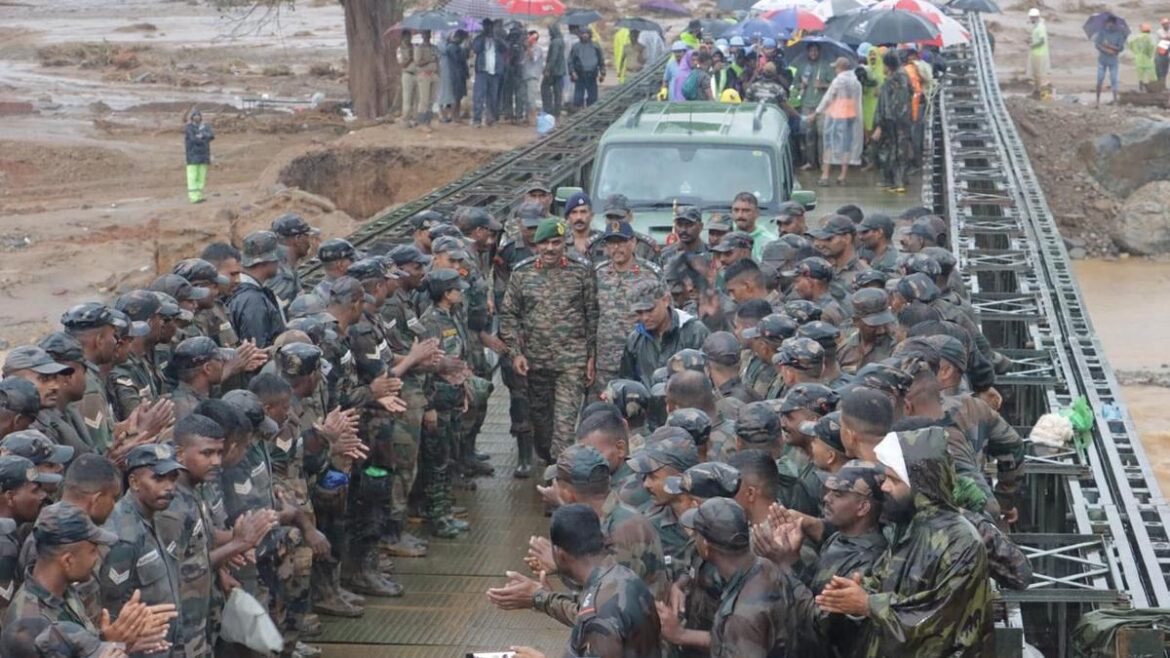Moving men, materials from far and wide to challenging Wayanad terrain

Over 470 Army personnel are involved in the rescue efforts in Wayanad.
| Photo Credit: Special arrangement.
It was around 4.30 a.m. on Tuesday that the Indian Army’s senior officers in Chennai received the first call about two landslides in Kerala’s Wayanad district. Within a few hours, the headquarters of the Army’s Dakshin Bharat area in Chennai put together a comprehensive rescue and relief plan and mobilised personnel, sniffer dogs and equipment from as far as Delhi and Meerut.
“As we were already prepared following the orange alert, we were able to move our personnel within a few hours of receiving information,” a senior Army officer told The Hindu. By 12.30 p.m. on Tuesday, personnel of the 122 Battalion of the Territorial Army were at the site. Reinforcements were sent in following their inputs. Soon, personnel from the Defence Security Corps (DSC) unit in Kannur reached the site.
What caused Wayanad landslides? Geoscientist points to unchecked human interventions, climate vagaries
Lieutenant-General Karanbir Singh Brar, General Officer Commanding, Dakshin Bharat Area was monitoring the rescue and relief efforts from Chennai. Rescue teams from the sites flagged the need for bailey bridges. Personnel from the Madras Engineer Group (aka the Madras Sappers) moved bailey bridges from Bengaluru and reached the area by 2 a.m. on Wednesday, an officer said.
An officer from the Parachute Regiment took over command of the rescue and relief operations. “As the bailey bridges from Bengaluru could be used only in limited stretches, bridges were flown in from Delhi”. Personnel of the Engineers Regiment, along with the long bailey bridges, were flown in using the Indian Air Force’s C-17 Globemaster aircraft from Delhi and arrived in Kozhikode.
It took about 25 vehicles to move the components of the bailey bridges to the site. “There were challenges. There was no electricity, it was raining and trucks with men and equipment had to negotiate a challenging terrain in the dark. With no mobile towers in some areas, satellite phones were used,” he said. The longest bailey bridge at the site now spans 190 feet.
Sniffer dogs were flown in from the Remount Veterinary Corps Centre and College from Meerut. “These dogs are trained and could sense if there are people trapped inside and if they are alive.” Drones are also being used by the Army to cover places that could not be reached as yet.
Wayanad landslides: Kerala CM’s office says chances of finding more survivors bleak
Though men and machinery were mobilised, deployment took time as roads were slushy and slippery, with fallen trees and branches strewn all over. Some roads had simply disappeared. “Actually, the men disembarked at a distance to clear the trees on the way so that the equipment on trucks could move forward.”
As of Thursday afternoon, over 470 Army personnel including about 20 Commissioned Officers and 25 Junior Commissioned Officers and over 80 trucks were involved in the rescue efforts, along with other agencies. The medical staff from the Military Hospital in Kannur too joined the efforts.
Read Comments
- Copy link
- Telegram
READ LATER
Remove
SEE ALL
PRINT
Related Topics
Tamil Nadu
/
avalanche/landslide
/
disaster management
/
Kerala
/
armed Forces

